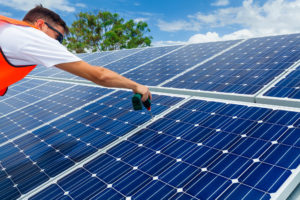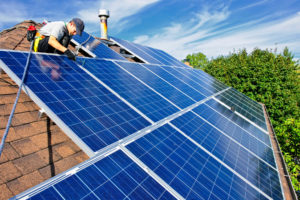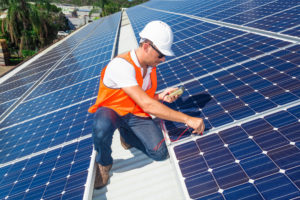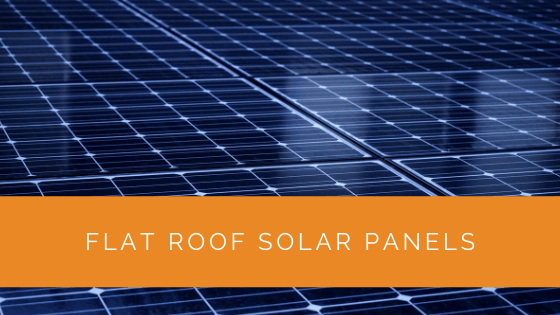In response to pressing environmental concerns, the global shift toward renewable energy sources is gaining rapid momentum. One noteworthy example of this transition is unfolding in the United Kingdom, where the adoption of renewable energy is rising.
In recent years, there has been a significant surge in the installation of solar power systems across the country. This trend isn’t limited to traditional sloped rooftops; flat-roof solar panels are gaining remarkable popularity in the United Kingdom, extending their application beyond commercial buildings to a wider range of structures. If you’re considering the installation of solar panels on a flat roof, this guide will provide valuable insights to help you make an informed decision.
Contents
- 1 Key Takeaways
- 2 Can You Install Solar Panels On a Flat Roof?
- 3 How Do Solar Panels Works On Flat Roofs
- 4 Different Ways To Install Solar Panels On A Flat Roof
- 5 The Pros and Cons of Flat Roof Solar Panel Installation
- 6 A Few Things To Keep In Mind Before Installing Solar Panels
- 7 Case Study: Maximising Energy Efficiency with Flat Roof Solar Panels in a Residential Setting
- 8 Expert Insights From Our Solar Panel Installers About Flat Roof Solar Panels
- 9 Discover the Power of Solar with Solar Panels Network
- 10 Summing Up
Key Takeaways
- Solar panels can be installed on flat roofs, also known as low-slope roofs, in the United Kingdom, and there are three primary installation methods: attached, ballasted, and foundation/footing.
- Advantages of flat roof solar panels include renewable and clean energy, cost savings, low maintenance, and permitted development status. However, challenges include dust and debris accumulation, cleaning difficulties, weather dependency, and longer return on investment.
- Before installing flat roof solar panels, consider factors such as planning permission, roof space, optimum angle, roof condition, warm roof compliance, and the need for an Energy Performance Certificate. Flat roof installations tend to be more cost-effective due to simpler logistics.
Can You Install Solar Panels On a Flat Roof?
Yes, you can install solar panels on a flat roof. Flat roofs are also called low-slope roofs with a minimal slope to accommodate a solar panel system.
You can also install solar thermal systems on a flat roof to warm your home in winter. Solar thermal panel installation is similar to a PV system and can be installed on a flat roof via a mounting track.
How Do Solar Panels Works On Flat Roofs
The solar panels on flat roofs work in the same manner as on pitched roofs. You lay the panels on flat roofs in the same way as you would on a steep roof.
However, this might restrict the panels from accumulating direct sunlight and result in water leakage. Hence, tilted-mounting systems must be installed along with the panels to avoid high winds and rainwater pooling damage.
Different Ways To Install Solar Panels On A Flat Roof
Solar panel systems are affordable and energy-smart, help reduce carbon footprint, and don’t harm the environment.
Solar panels on a flat roof can be installed in three ways: attached, ballasted, and foundation or footing. The installation type generally depends upon the choice and convenience of the house owners to avoid water leaks and maximise their utility.
Attached
The attached installation is done when very few parapet walls are on the roof. The parapet wall acts as an uplift windbreaker and reduces any possible effects of wind pressure on the solar panels.
The attached installation is usually opted for to avoid any harm or damage from wind speeds, making it the most expensive installation process.
The installation consists of chemical anchoring via resin injection into the drilled hole, followed by studs. This process eliminates any irregularities and makes the roof 100% leakage-proof.
Furthermore, the chemical anchoring also strengthens the solar mounting structure fixed to the roof.

Ballasted
The ballasted installation process keeps the solar panel racking system in place. Solar panel racking system refers to a specific type of mounting system to firmly fix the solar panels on the roof.
The ballasted process is quick and easy, unlike the attached installation system. Additionally, this process doesn’t involve drilling or any chemical anchoring.
Foundation Or Footing
The foundation or footing installation system is generally opted for at storm-prone locations. The primary utility of this process is to keep the solar racking system safely intact on the roof.
Concrete blocks are used as footings for the solar racking system to bear the brunt of heavy solar PV systems. However, high parapet walls on a flat roof are required to install solar panels via this process.
Drilling holes are unnecessary as concrete blocks are moulded over the flat roof to keep the racking system intact.
The silver lining of the foundation installation process is the guaranteed leak-proof roof with quick installation. Furthermore, it also elevated the PV solar modules for maximum utilisation.
The Pros and Cons of Flat Roof Solar Panel Installation
Installing a solar panel system does boast many advantages, and the tempting electric bill cut, so do its cons. Solar panel installation has its fair share of advantages and disadvantages, listed below for your reference.
Advantages
Renewable And Clean Energy
Since the sun is an ever-lasting energy source, installing solar panels becomes a cost-effective solution to the current fossil energy crisis.
Due to rapid technological advances, solar energy is becoming a better and cleaner energy source. Furthermore, solar PV panels have a minimal carbon footprint, and their primary materials can be recycled numerous times.
A Decent Bill Cut
Solar panel installation projects save money as decent electricity bills accompany them. You become less dependent on the National Grid for your electricity supply.
Generating your energy source allows you to enjoy cheap and efficient electricity in the long run. Furthermore, if you invest in battery storage, you won’t need to subscribe to any electricity.
Battery storage acts as energy storage and an energy bank for utilisation on cloudy days or evenings.

Self Cleaning & Low Maintenance
Solar panels boast very little maintenance and longer efficiency. They are usually arranged and fixed at an angle that removes dust and dirt. Furthermore, the rain usually washes it away in case of any accumulation.
Solar panels also prevent energy loss, which is inevitable if transmitted from a power plant. They are self-cleaning and highly efficient energy tools.
Permitted Development
Since solar panels are ‘permitted development,’ there’s no need for planning permission for installation. Furthermore, solar panels are also an excellent investment.
Given the current energy trends, solar panels prices might rise and can cost you a handsome amount.
Disadvantages
Dust and Debris Accumulation
Dust and debris accumulate relatively quickly on flat roof solar panels, which might be a considerable challenge. Solar panels can work effectively and efficiently for as long as 25 years if they don’t accumulate dust.
However, its efficient lifespan can be cut in half if the accumulation of dust and debris is not prevented. It becomes more challenging in flat roof solar panels as flat roofs pool more dust and water than others.
Cleaning A Challenge
Although the solar panels are fixed and arranged to allow rain to wash the solar panels clean, flat roofs pool water a lot and might not be self-cleaning.
It’s always possible for the rainwater to accumulate in the roof along with all the dirt and debris.
Furthermore, no matter what type of process you opt for, there’ll always be the potential risk of water leakage. Hence, you might cut on the electricity bill but, at the same time, add to your plumbing utility.
Less Solar Energy
The flat roof solar panels’ efficient accumulation of solar energy highly depends on the weather conditions. Although solar panels can collect and store sunlight, even on cloudy days, the efficiency drops significantly.
And unless you invest in battery storage, you might want to be wary of your energy usage as you cannot collect sunlight at night or evening.
Furthermore, you might want to invest in thermodynamic panels if you want a working water heating system during winter. Then again, even though thermodynamic panels are a great alternative to flat roof solar panels, they are expensive.
Longer Return On Investment and Lesser Benefit
Even though solar panels are affordable, add the entire installation along with the equipment, the cost is pretty high.
In addition, the solar energy system can only convert about 20% to 25% of solar energy that hits its surface to energy. This, again, is dependent on the visibility of the sun.
The return on investment of flat roof solar panels is rather long and cannot be expected to fruit quickly.
A Few Things To Keep In Mind Before Installing Solar Panels
Solar panels certainly do offer a range of benefits and limitations. However, a few things must be considered before you consider installing it.
A few of them are listed below!
Planning Permission
Even though solar panels are labelled as ‘permitted development,’ all domestic properties must acquire ‘planning permission’ for installation projects.
However, this is not true for commercial flat roof solar panel installation.

More Roof Space
Flat roof solar panel installation demands more space than a sloped roof solar panel installation system to prevent possible shading effects.
Shading effects refer to the solar panels over-shadowing each other due to less space, resulting in less solar energy conversion. A minimum space of 0.5m to 1 m is a must between the edge of the roof and the solar system.
Optimum Angle
Flat roof solar panels are kept intact to the roof by fitting ballast frames, unlike the ‘free-standing’ system. Hence, the flat roof must have the required structure to support these heavy ballasts.
The solar panels must be mounted either south-facing or east-west to optimise space and minimise ballast brunt. The angle must be horizontally around 10-12 degrees.
Roof Condition
The impact of flat roof panel installation on the roof must be calculated beforehand to avoid compromising safety and water leakage.
A roof membrane must be installed before the installation of solar panels. This is because the season post-solar panel installation change can affect your roof structure.
Warm Roof Functioning
Flat roof systems are required to comply with the Building Regulation, Part L, in the United Kingdom. According to this regulation, all flat roofs must have a warm roof construction.
Hence, it’s crucial to ensure that installing the flat roof panels doesn’t compromise the warm roof.
Energy Performance Certificate
Lastly, an Energy Performance Certificate (EPC) is a must.
An EPC displays the energy efficiency of a building, with ‘A’ being the most efficient and ‘G’ the least. You can get this certification via any accredited energy-assessing agency.
Cost Of Installing Solar Panels On Flat Roof
Usually, installing solar panels on a flat roof can cost around £750 – £900 per kW, whereas it costs about £1,250 per kW for pitched roofs.
The cheaper rates of flat solar panel systems are primarily due to lesser logistics. Unlike a steep roof, a flat roof system doesn’t require specialised equipment for safety purposes.
Your local solar installers can work around the flat roof slope safely and freely, making the process relatively cheaper.
Case Study: Maximising Energy Efficiency with Flat Roof Solar Panels in a Residential Setting
Background
Solar Panels Network recently completed a solar installation project for a residential property in the UK. The homeowner had a flat roof and was interested in leveraging solar energy to reduce electricity bills and increase energy independence. The project aimed to install a solar PV system on the flat roof while addressing specific challenges such as optimising panel placement and ensuring the structural integrity of the roof.
Project Overview
The homeowner sought a sustainable energy solution that would be cost-effective and efficient. With ample flat roof space available, the property was an ideal candidate for a solar PV system. The main objectives were to reduce reliance on grid electricity, achieve significant cost savings, and contribute positively to the environment.
Implementation
- System Design and Planning: Our team conducted a thorough assessment of the roof’s condition, ensuring it could support the additional weight of the solar panels and mounting systems. The design phase included selecting the most efficient layout to maximise sunlight exposure and minimise shading.
- Installation Process:
- Mounting System Selection: Given the flat roof structure, we opted for a ballasted mounting system, which involved securing the panels with concrete blocks. This method avoided the need for drilling, thereby preserving the roof’s waterproofing.
- Panel Installation: The solar panels were installed at a 10-degree tilt to optimise sunlight capture, following a south-facing orientation. This configuration was chosen to enhance the system’s efficiency and energy yield.
- Inverter and Wiring Setup: A high-efficiency inverter was installed to convert the DC power generated by the panels into usable AC power. The wiring was neatly arranged to ensure safety and aesthetic appeal.
Results
- Cost Savings: The homeowner experienced a noticeable reduction in monthly electricity bills, with a projected annual saving of approximately £1,200. This saving was primarily due to the significant amount of electricity generated by the new system.
- Environmental Impact: The installation contributed to a substantial reduction in the household’s carbon footprint, aligning with the homeowner’s environmental goals.
- System Performance: The flat roof installation proved highly effective, achieving optimal energy production even during less sunny periods. The ballasted system also provided the added benefit of easy maintenance and adjustments.
Summary
This residential project showcases the viability and benefits of installing solar PV systems on flat roofs. By carefully planning and implementing a ballasted mounting system, Solar Panels Network ensured the project’s success, meeting the homeowner’s energy efficiency and sustainability goals. The project highlights the importance of considering roof type and structural integrity in solar installations, demonstrating that flat roof systems can be a practical and effective solution for residential properties.
This case study underscores the value of professional expertise in designing and installing solar systems, ensuring maximum efficiency and long-term benefits for homeowners.
Expert Insights From Our Solar Panel Installers About Flat Roof Solar Panels
Flat roof solar panels offer a unique advantage due to their flexibility in positioning. With the right mounting systems, we can optimise the angle for maximum sun exposure, ensuring you get the most out of your solar investment.
Senior Solar Installation Engineer
Installing solar panels on a flat roof can be more cost-effective than on a pitched roof. The process is generally quicker and safer, and the system can be easily maintained, which is a big plus for many homeowners.
Lead Solar Technician
One of the critical considerations for flat roof solar panels is ensuring the roof’s integrity. Proper installation includes securing the panels against strong winds and preventing any potential water leakage, which we always prioritise in our projects.
Solar Project Manager
Discover the Power of Solar with Solar Panels Network
Are you navigating the world of solar installations? Look no further than Solar Panels Network, the UK’s trusted partner in harnessing the sun’s potential. Our dedication goes beyond just installations; we’re on a mission to transform how homeowners and businesses across the UK perceive and utilise energy. By choosing us, you’re reducing your carbon footprint and making a smart financial move that promises savings for years ahead. Contact us today and embark on your solar journey.
Summing Up
With all said and done, it’s important to weigh both sides of the flat roof panel installation system along with the needed consideration.
That being said, the flat roof solar panel installation demands numerous careful considerations and limitations. It doesn’t mean that it isn’t worth investing.
Instead, taking the advice and opinion of an expert on the matter would be much better to make an informed decision on your end.
About the Author
Solar Panels Network stands at the forefront of solar energy solutions, driven by a team of seasoned solar engineers and energy consultants. With over decades of experience in delivering high-quality solar installations and maintenance, we are committed to promoting sustainable energy through customer-centric, tailored solutions. Our articles reflect this commitment, crafted collaboratively by experts to provide accurate, up-to-date insights into solar technology, ensuring our readers are well-informed and empowered in their solar energy decisions.

